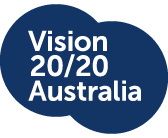MEDIA RELEASE
- Australia’s first National Eye Health ‘Heat Map’ highlights the significant disparity between regional and metropolitan Australia with regard to optometric eye care.
- Reduced Federal Government investment will only contribute to immediate and long-term eye health risk for millions of Australians.
- These outcomes reinforce Optometry Australia’s call for the Australian Government to reverse the 5 per cent cut to the optometric Medicare rebate in the forthcoming Federal budget, to protect equitable access to optometric eye care for all Australians.
Thousands of Australians living in regional areas are facing an increased risk of long-term eye and vision issues due to limited access to optometric services, according to an innovative national research project unveiled today.
The launch of the National Eye Health Heat Map (NEHHM), an interactive online eye health mapping tool developed by Optometry Australia and hosted by the Australian National University (ANU), reveals Australians living in regional areas have significantly higher levels of unmet need for optometric eye care compared with those living in metropolitan areas.
According to Optometry Australia President Kate Gifford, this disparity between regional and metro areas for optometric eye care will likely become greater with the recent 5 per cent cut to the optometric Medicare rebate and extended freeze on indexation of Medicare rebates until July 2018.
“Although we intuitively had believed this disparity between regional and metro areas to be the case, our heat map provides the first empirical profile of the ‘hot spots’ that exist for optometric eye care across Australia.
“While there are some pockets of high unmet need within metropolitan areas, our greatest concern is for Australians living in inner and outer regional areas who experience difficulty in accessing essential optometric services as a result of geographical and socio-economic factors,” Mrs Gifford said.
With the federal budget due to be handed down next week, Optometry Australia has called on the Australian Government to reverse the 5 per cent cut to the optometric Medicare rebate to protect equitable access to optometric eye care for all Australians.
“We are concerned that those who cannot afford an out-of-pocket expense will avoid seeing an optometrist and when you consider that 80 per cent of all vision impairment is preventable or treatable, it’s essential the Government commits to policies that reduce financial barriers for patients to access optometric eye care such as fairer rebates and direct billing under Medicare.
“The Government needs to urgently strengthen its funding of optometry services under Medicare and we hope that the 2015 Federal Budget will deliver this,” Mrs Gifford said.
NEHHM was developed specifically by Australia’s peak optometry body to provide a visual representation of the estimated unmet need for optometric eye care across Australia. The tool displays composite data sets from Australian Bureau of Statistics, the former Health Workforce Australia, Department of Human Services and Medicare Australia to give an “eye care need” score based on relevant factors such as estimated prevalence of different eye conditions and associated risk factors, provision of optometric services and important demographic factors which combined, provide an insight into the eye care needs of Australians.
According to the NEEHM, South Australia’s Mallee and Murray regions, New South Wales’ Lachlan Valley and Western Australia’s Mandurah region have some of the highest estimated levels of unmet need for optometric eye care across Australia. Conversely, affluent metropolitan areas such as Melbourne’s Port Phillip and Stonnington precincts lead the way with the lowest estimated need for optometric eye care.
Paul Konings, Spatial Scientist with the National Centre for Geographic and Resource Analysis in Primary Health Care (GRAPHC) at ANU, said the heat map tool provides a sophisticated insight into Australia’s healthcare landscape including disparities in service provision.
“The NEHHM is an interactive, spatial mapping tool that can display various information identified as being relevant to the eye health of the Australian community. We were excited to work with Optometry Australia on this leading project to assist in identifying the eye health needs of the Australian community”, he said.
ENDS
About Optometry Australia
Optometry Australia is the peak professional body for optometrists. Representing more than 90 per cent of all Australian-based optometrists, Optometry Australia’s focus is to lead and advance the profession of optometry by putting eye-health front and centre of Australian health care. For more information visit the Optometry Australia website.
Media Contact
- Richard Amos, Royce Communications, +61 418 344 978
- Tony Faccenda, Royce Communications +61 411 231 433
